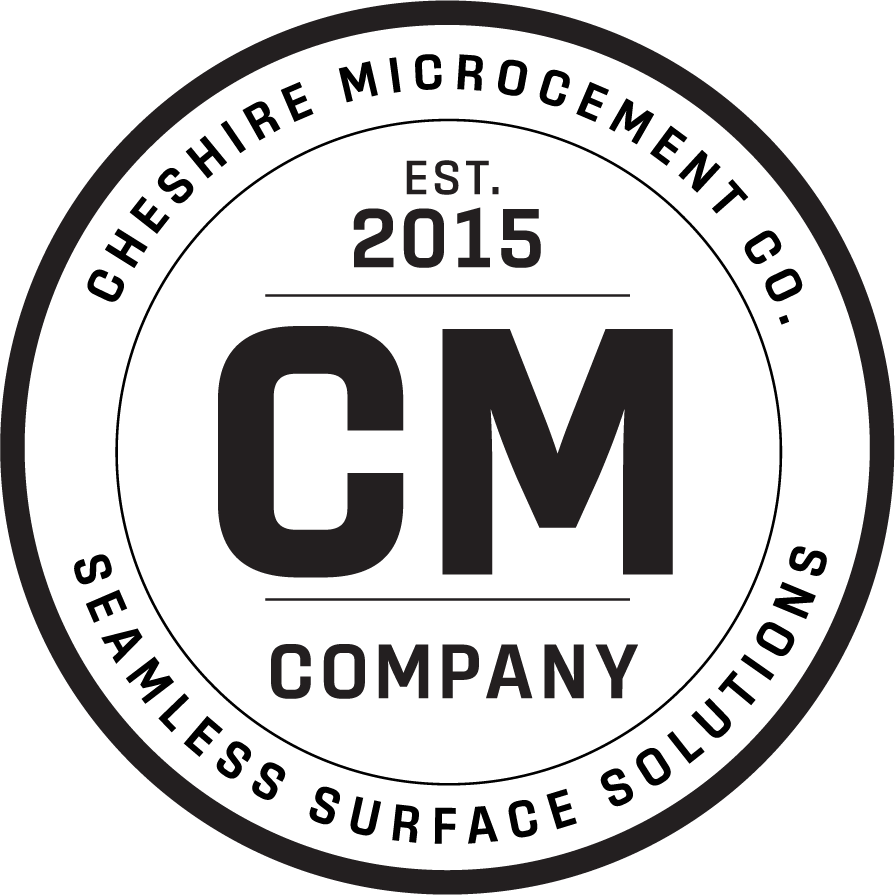
FAQ
-
WHAT IS MICROCEMENT?
Microcement is a high-performance, decorative coating composed of cement, polymers, aggregates, and pigments. It creates a seamless, ultra-thin layer—usually between 3 to 4 millimetres thick—that can be applied over existing surfaces such as concrete, tiles, plaster, or wood. This versatility allows for a smooth, continuous finish without the need for joints or grout lines.
Its popularity stems from its durability, water resistance, and aesthetic flexibility. Available in an array of colours and textures, microcement is ideal for both residential and commercial applications including floors, walls, ceilings, bathrooms, kitchens and furniture. Additionally, it offers a modern, minimalist yet natural look while being easy to maintain, making it a leading choice for innovative seamless surface solutions.
-
Why choose the Cheshire microcement co?
Choosing a professional microcement installer such as us at The Cheshire Microcement Co, ensures a flawless finish that enhances the beauty and durability of your surfaces. Microcement application requires precision and expertise to achieve the seamless, sleek look it is known for. We bring extensive knowledge of material preparation, mixing ratios, and application techniques that prevent common issues such as cracking, peeling, or uneven surfaces. We also have an artistic approach to our craft and knowledge of the application techniques required top achieve different finishes, textures, tones and even embossed pattern or logo work.
Moreover, we understand the importance of substrate preparation and moisture control, which directly affects the longevity of the microcement surface. Our skill in colour matching and layering creates bespoke finishes tailored to your aesthetic preferences, elevating your space with a truly unique and contemporary look.
Attempting a DIY approach or using inexperienced installers can result in costly repairs and subpar results that undermine the quality and appeal of microcement.
-
is it expensive?
The cost of microcement installation varies depending on the specifics of each job, which is why we don’t provide fixed prices online. Numerous factors influence the total cost, including the preparation required, and the chosen system and finish.
For larger areas, we typically price per square meter, with costs ranging from £160 to £180 per square meter, including both supply and installation. Prices may be higher for specialized finishes like terrazzo or for smaller areas, where the efficiency of the precess is reduced, due to the drying times required between each coat.
Now if you're comparing this to some of the cheapest tiles available, then yes, microcement will not compete. However, if being compared to high end porcelain, and all the other products required for a sound tile installation are factored in, such as waterproofing, backer board, anti fracture membranes, tile adhesive and installation. Well then microcement actually becomes a cheaper proposition, not to mention all the other benefits of the product.
When compared to high-end engineered wood flooring, the pricing is similar. That said, if you’re comparing microcement to entry-level flooring options like laminate, luxury vinyl tile (LVT), or vinyl flooring, microcement will typically be the more premium—and therefore more expensive choice.
-
strengths and weaknesses?
The major strength of microcement is its versatility, both in where it can be applied, and the bespoke nature of the looks which can be achieved.
It is so easy to maintain and clean. In that there isn’t really any maintenance required. And its stain resistance is fantastic. Spilt some red wine or coffee? It happens. Just wipe it off straight away or after it’s dried, no harm done.
It is seamless. No matter how big the area. It requires no grout lines or expansion joints. We’ve all experienced the nightmare of trying to get stains out of grout lines or timber flooring.
The one downside, which depends on your priorities really, is impact resistance. It won’t ever crack like a tile, however, if mistreated, it may dent slightly, if a heavy object was to fall on it from a height. In this area it is best compared to a hard wood floor.
-
How long does installation take?
That really depends on the preparation of the substrate required, and the look, texture, movement which the customer is looking to achieve. Normally this would be between 5 and 8 days.
Around 24hrs after the final coat is applied the area can be put into light use. After 48hrs the microcement will be at around 80% hardness and can be used as normal. However a little care should be taken, as full hardness isn’t achieved until 28 days after installation.
-
where can microcement be used?
As long as the right preparations of the substrate have taken place, microcement can be used almost anywhere - floors, walls and ceilings, worktops, furniture, bathrooms, wet rooms, steam rooms, patios and swimming pools.
It can be used as a new floor, worktop or bathroom, but can also be used over existing tile or stone surfaces, offering fantastic value for money.
Most bathroom renovations, where tiles are being used, will require the existing tiles to be removed, remedial work to the now damaged substrate, application of waterproof tanking systems and all the mess and time that this takes. Microcement is both the finish and the tanking system, so is perfect for over tile installations, saving time, money and with truly beautiful results.
-
Do you offer microcement installation near me?
Yes — we cover a wide area across the North West including Cheshire, Manchester, Liverpool, Sheffield and nearby towns. If you’re searching for a microcement installer near you, we’d love to help.

